

Slide 1 / 16 Slide 2 / 16 New Jersey Center for Teaching and Learning BIOLOGY Progressive Science Initiative This material is made freely available at www.njctl.org and is intended for the non-commercial use of Osmosis Lab students and teachers. These materials may not be used for any commercial purpose without the written permission of the owners. NJCTL maintains its website for the convenience of teachers who wish to make their work available to other teachers, participate in a virtual professional learning Membranes & Enzymes community, and/or provide access to course materials to parents, students and others. www.njctl.org Click to go to website: www.njctl.org http:/ / njc.tl/ 16 http:/ / njc.tl/ 6 Slide 3 / 16 Slide 4 / 16 Problem Materials 6 clear cups 10 ml 1.0 M Sucrose solution What determines the direction of osmotic flow? 6 pieces of 15 cm Dialysis 1 Marking pencil tubing Labeling tape Hypotheses: 12 pieces string 10 cm in length Calculator 1 plastic medicine cup Paper towels 10 ml Distilled water Balance 10 ml 0.2 M Sucrose solution Enough distilled water to cover 10 ml 0.4 M Sucrose solution dialysis tubes in cups 10 ml 0.6 M Sucrose solution 10 ml 0.8 M Sucrose solution Slide 5 / 16 Slide 6 / 16 Procedure Procedure Step 7 Place the appropriate dialysis tube into each of the Step 1 Obtain six plastic cups and number them from 1 to 6. numbered cups and fill each cup with enough distilled water to Step 2 Obtain six pieces of soaked dialysis tubing. Open one end completely cover each tube. of each tube by gently rubbing it in between your fingers. Tie one Step 8 Begin timing for a total of 30 minutes. end of each tube off with a piece of string. Step 9 After 30 minutes have passed, remove each dialysis tube Step 3 Using a measuring cup, measure out 10 ml of each of the from its container and gently blot any excess water from its surface. six solutions. Step 10 Record the final mass of each bag in Table 2 and then Step 4 Pour the contents of one solution into the first dialysis tube calculate the percent change in mass for each tube. % Change = and tie it closed with another piece of string. Continue to do the (Final Mass – Initial Mass)/Initial Mass x 100. Record the class same thing with the remaining five solutions. Make sure to rinse averages for % Change in Mass in Table 3. out the measuring cup in between solutions. Step 11 Construct two graphs. The first graph will be of your Step 5 Rinse the outside of each dialysis tube with running water group’s % Change in Mass. The second graph will be the class and then use paper towels to dry the outside of each bag. average of the % Change in Mass for each dialysis tube. Step 6 Record the initial mass of each bag in Table 2.
Slide 7 / 16 Slide 8 / 16 Data Class Data Dialysis Bag Dialysis Bag Change in % Change in Group # Distilled 0.2 M 0.4 M 0.6 M 0.8 M 1.0 M Solution Initial Mass Final Mass Mass (g) Mass Water Sucrose Sucrose Sucrose Sucrose Sucrose (g) (g) 1 Water 2 0.2 M 3 0.4 M 4 0.6 M 5 0.8 M 6 1.0 M Slide 9 / 16 Slide 10 / 16 1 What is osmosis and how does it differ from simple diffusion? Osmosis Lab Students type their answers here Grade: «grade» Subject: «subject» Date: «date» Slide 11 / 16 Slide 12 / 16 2 In which of the six setups in this experiment do you think osmosis 3 Explain the relationship of the distilled water in each beaker to the occurred? Explain. solution inside the dialysis tubes with regards to tonicity (solutes Students type their answers here concentration). Students type their answers here
Slide 13 / 16 Slide 14 / 16 4 What do you think would happen if you placed each dialysis tube in 5 Why was it important to calculate and plot % Change in Mass as a solution containing 0.4 M Sucrose instead of distilled water? opposed to just using the absolute change in mass of each dialysis Students type their answers here tube? Students type their answers here Slide 15 / 16 Slide 16 / 16 6 What do you think would happen if you took some of your red 7 On a hot day, under normal conditions, why is it better to drink blood cells and placed them in distilled water? What would happen water to stay hydrated as opposed to drinking fluids containing salt to these cells if you placed them in 1.0 M sucrose solution? What or other solutes? would happen if you placed them in blood plasma? Students type their answers here Students type their answers here
Recommend
More recommend